Personal Reflection Australia Report 2022
VerifiedAdded on 2022/10/01
|9
|2233
|31
AI Summary
Contribute Materials
Your contribution can guide someone’s learning journey. Share your
documents today.
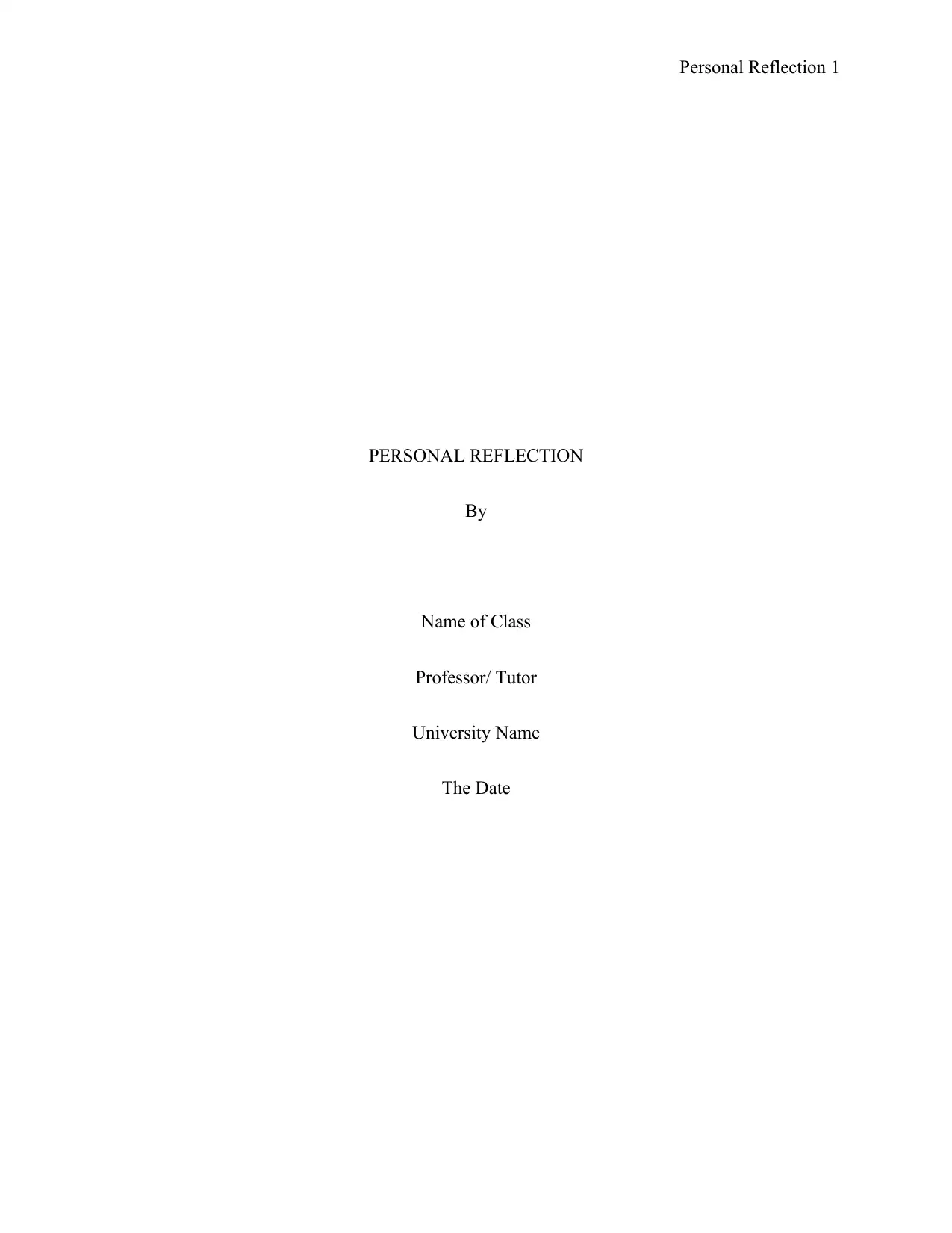
Personal Reflection 1
PERSONAL REFLECTION
By
Name of Class
Professor/ Tutor
University Name
The Date
PERSONAL REFLECTION
By
Name of Class
Professor/ Tutor
University Name
The Date
Secure Best Marks with AI Grader
Need help grading? Try our AI Grader for instant feedback on your assignments.
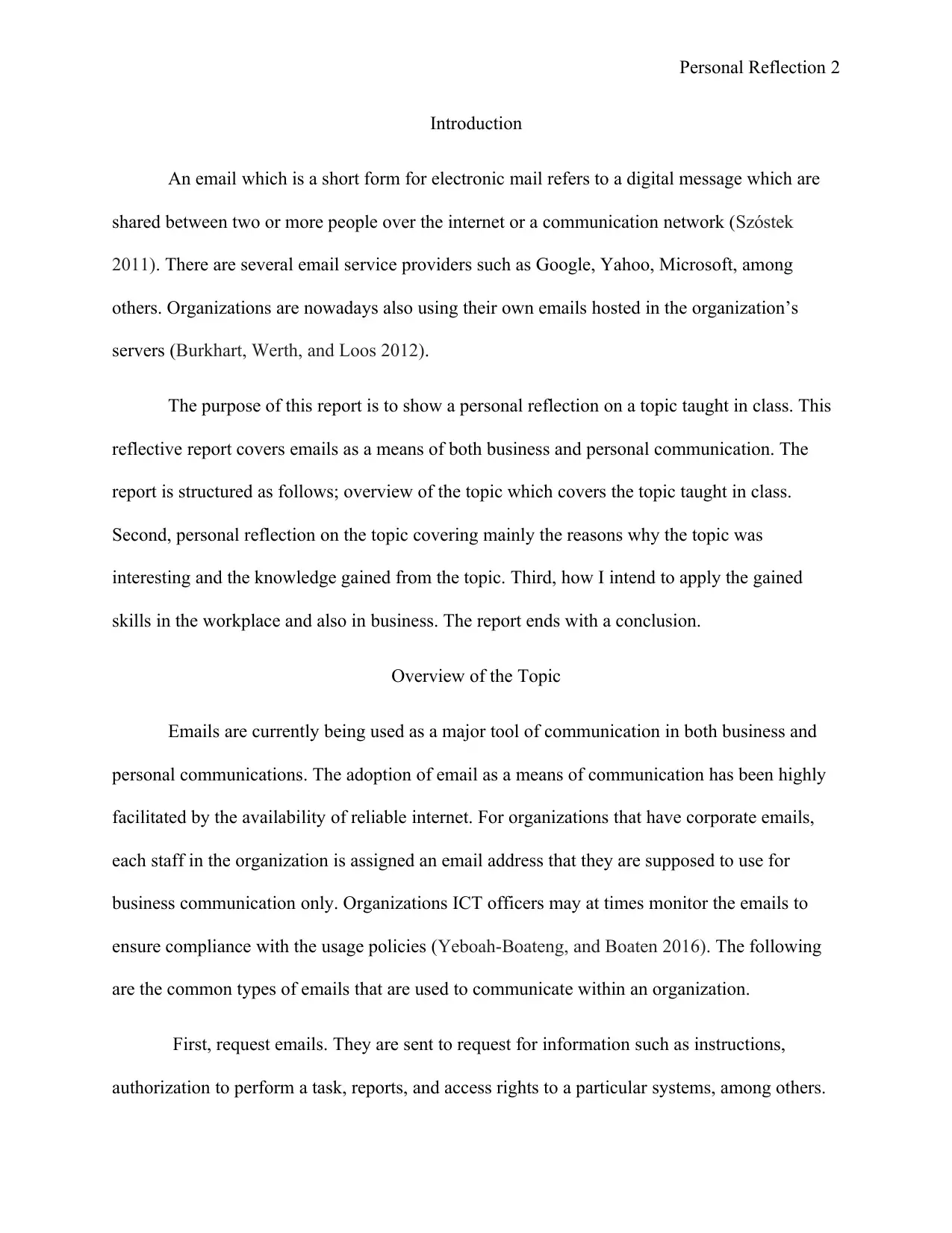
Personal Reflection 2
Introduction
An email which is a short form for electronic mail refers to a digital message which are
shared between two or more people over the internet or a communication network (Szóstek
2011). There are several email service providers such as Google, Yahoo, Microsoft, among
others. Organizations are nowadays also using their own emails hosted in the organization’s
servers (Burkhart, Werth, and Loos 2012).
The purpose of this report is to show a personal reflection on a topic taught in class. This
reflective report covers emails as a means of both business and personal communication. The
report is structured as follows; overview of the topic which covers the topic taught in class.
Second, personal reflection on the topic covering mainly the reasons why the topic was
interesting and the knowledge gained from the topic. Third, how I intend to apply the gained
skills in the workplace and also in business. The report ends with a conclusion.
Overview of the Topic
Emails are currently being used as a major tool of communication in both business and
personal communications. The adoption of email as a means of communication has been highly
facilitated by the availability of reliable internet. For organizations that have corporate emails,
each staff in the organization is assigned an email address that they are supposed to use for
business communication only. Organizations ICT officers may at times monitor the emails to
ensure compliance with the usage policies (Yeboah-Boateng, and Boaten 2016). The following
are the common types of emails that are used to communicate within an organization.
First, request emails. They are sent to request for information such as instructions,
authorization to perform a task, reports, and access rights to a particular systems, among others.
Introduction
An email which is a short form for electronic mail refers to a digital message which are
shared between two or more people over the internet or a communication network (Szóstek
2011). There are several email service providers such as Google, Yahoo, Microsoft, among
others. Organizations are nowadays also using their own emails hosted in the organization’s
servers (Burkhart, Werth, and Loos 2012).
The purpose of this report is to show a personal reflection on a topic taught in class. This
reflective report covers emails as a means of both business and personal communication. The
report is structured as follows; overview of the topic which covers the topic taught in class.
Second, personal reflection on the topic covering mainly the reasons why the topic was
interesting and the knowledge gained from the topic. Third, how I intend to apply the gained
skills in the workplace and also in business. The report ends with a conclusion.
Overview of the Topic
Emails are currently being used as a major tool of communication in both business and
personal communications. The adoption of email as a means of communication has been highly
facilitated by the availability of reliable internet. For organizations that have corporate emails,
each staff in the organization is assigned an email address that they are supposed to use for
business communication only. Organizations ICT officers may at times monitor the emails to
ensure compliance with the usage policies (Yeboah-Boateng, and Boaten 2016). The following
are the common types of emails that are used to communicate within an organization.
First, request emails. They are sent to request for information such as instructions,
authorization to perform a task, reports, and access rights to a particular systems, among others.
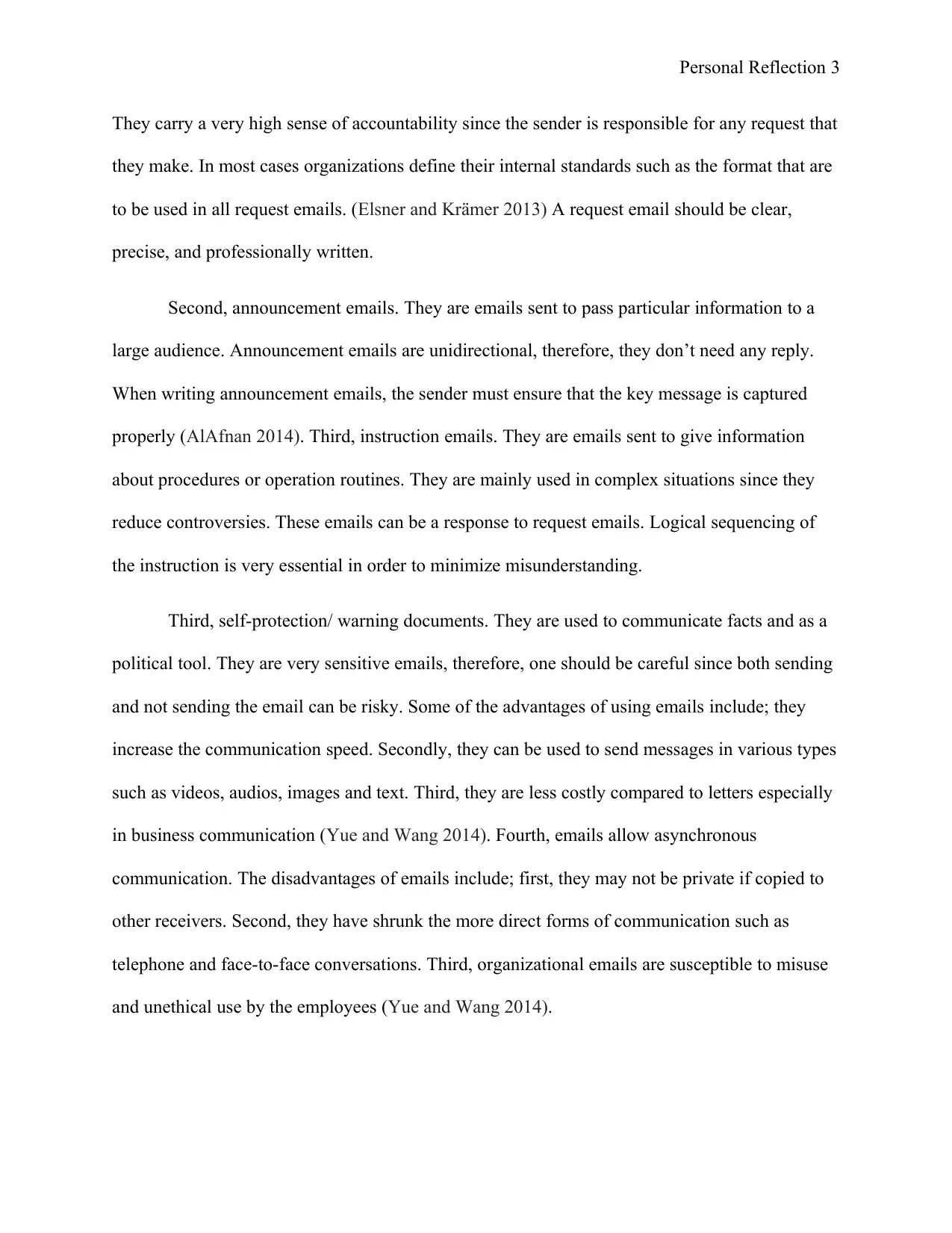
Personal Reflection 3
They carry a very high sense of accountability since the sender is responsible for any request that
they make. In most cases organizations define their internal standards such as the format that are
to be used in all request emails. (Elsner and Krämer 2013) A request email should be clear,
precise, and professionally written.
Second, announcement emails. They are emails sent to pass particular information to a
large audience. Announcement emails are unidirectional, therefore, they don’t need any reply.
When writing announcement emails, the sender must ensure that the key message is captured
properly (AlAfnan 2014). Third, instruction emails. They are emails sent to give information
about procedures or operation routines. They are mainly used in complex situations since they
reduce controversies. These emails can be a response to request emails. Logical sequencing of
the instruction is very essential in order to minimize misunderstanding.
Third, self-protection/ warning documents. They are used to communicate facts and as a
political tool. They are very sensitive emails, therefore, one should be careful since both sending
and not sending the email can be risky. Some of the advantages of using emails include; they
increase the communication speed. Secondly, they can be used to send messages in various types
such as videos, audios, images and text. Third, they are less costly compared to letters especially
in business communication (Yue and Wang 2014). Fourth, emails allow asynchronous
communication. The disadvantages of emails include; first, they may not be private if copied to
other receivers. Second, they have shrunk the more direct forms of communication such as
telephone and face-to-face conversations. Third, organizational emails are susceptible to misuse
and unethical use by the employees (Yue and Wang 2014).
They carry a very high sense of accountability since the sender is responsible for any request that
they make. In most cases organizations define their internal standards such as the format that are
to be used in all request emails. (Elsner and Krämer 2013) A request email should be clear,
precise, and professionally written.
Second, announcement emails. They are emails sent to pass particular information to a
large audience. Announcement emails are unidirectional, therefore, they don’t need any reply.
When writing announcement emails, the sender must ensure that the key message is captured
properly (AlAfnan 2014). Third, instruction emails. They are emails sent to give information
about procedures or operation routines. They are mainly used in complex situations since they
reduce controversies. These emails can be a response to request emails. Logical sequencing of
the instruction is very essential in order to minimize misunderstanding.
Third, self-protection/ warning documents. They are used to communicate facts and as a
political tool. They are very sensitive emails, therefore, one should be careful since both sending
and not sending the email can be risky. Some of the advantages of using emails include; they
increase the communication speed. Secondly, they can be used to send messages in various types
such as videos, audios, images and text. Third, they are less costly compared to letters especially
in business communication (Yue and Wang 2014). Fourth, emails allow asynchronous
communication. The disadvantages of emails include; first, they may not be private if copied to
other receivers. Second, they have shrunk the more direct forms of communication such as
telephone and face-to-face conversations. Third, organizational emails are susceptible to misuse
and unethical use by the employees (Yue and Wang 2014).
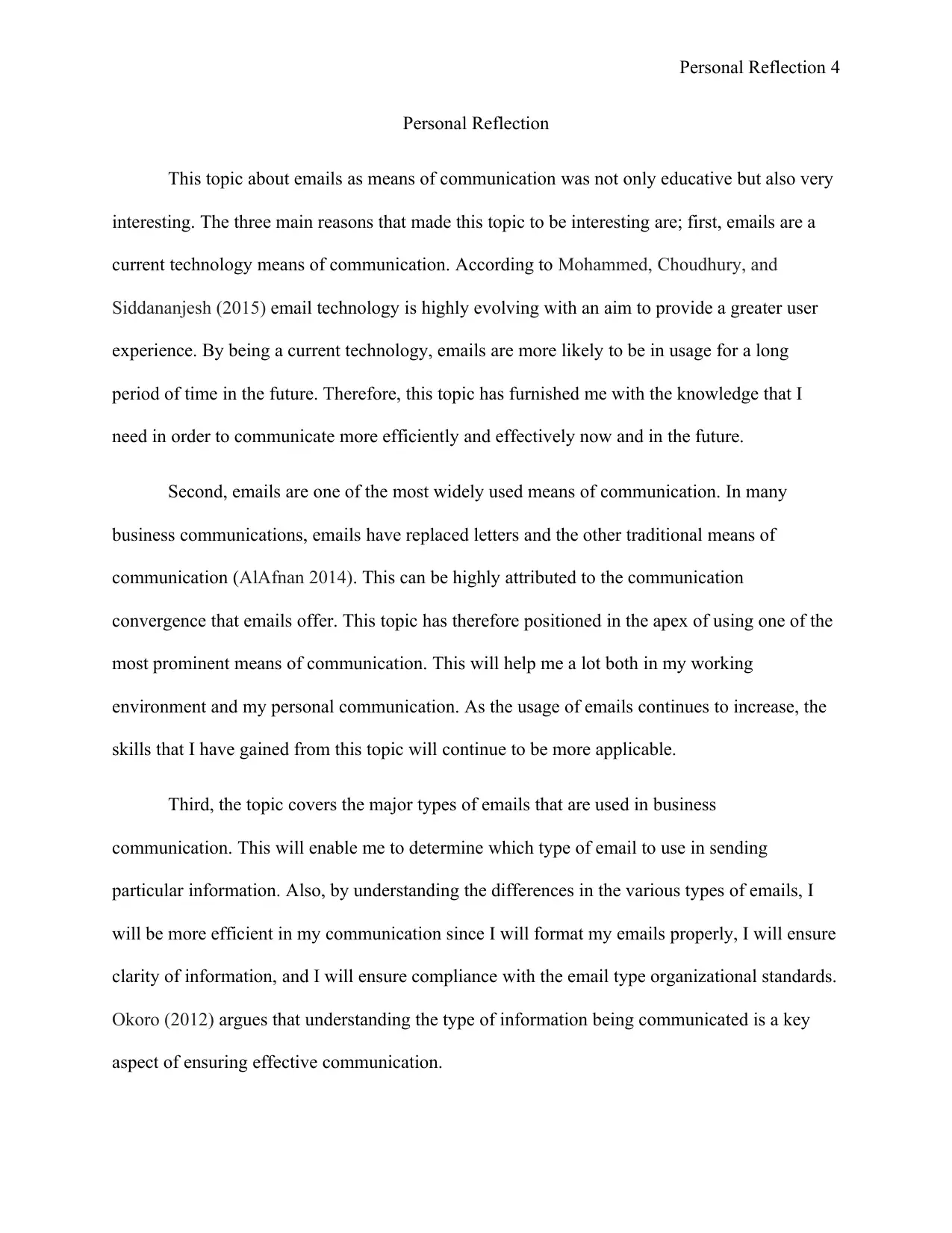
Personal Reflection 4
Personal Reflection
This topic about emails as means of communication was not only educative but also very
interesting. The three main reasons that made this topic to be interesting are; first, emails are a
current technology means of communication. According to Mohammed, Choudhury, and
Siddananjesh (2015) email technology is highly evolving with an aim to provide a greater user
experience. By being a current technology, emails are more likely to be in usage for a long
period of time in the future. Therefore, this topic has furnished me with the knowledge that I
need in order to communicate more efficiently and effectively now and in the future.
Second, emails are one of the most widely used means of communication. In many
business communications, emails have replaced letters and the other traditional means of
communication (AlAfnan 2014). This can be highly attributed to the communication
convergence that emails offer. This topic has therefore positioned in the apex of using one of the
most prominent means of communication. This will help me a lot both in my working
environment and my personal communication. As the usage of emails continues to increase, the
skills that I have gained from this topic will continue to be more applicable.
Third, the topic covers the major types of emails that are used in business
communication. This will enable me to determine which type of email to use in sending
particular information. Also, by understanding the differences in the various types of emails, I
will be more efficient in my communication since I will format my emails properly, I will ensure
clarity of information, and I will ensure compliance with the email type organizational standards.
Okoro (2012) argues that understanding the type of information being communicated is a key
aspect of ensuring effective communication.
Personal Reflection
This topic about emails as means of communication was not only educative but also very
interesting. The three main reasons that made this topic to be interesting are; first, emails are a
current technology means of communication. According to Mohammed, Choudhury, and
Siddananjesh (2015) email technology is highly evolving with an aim to provide a greater user
experience. By being a current technology, emails are more likely to be in usage for a long
period of time in the future. Therefore, this topic has furnished me with the knowledge that I
need in order to communicate more efficiently and effectively now and in the future.
Second, emails are one of the most widely used means of communication. In many
business communications, emails have replaced letters and the other traditional means of
communication (AlAfnan 2014). This can be highly attributed to the communication
convergence that emails offer. This topic has therefore positioned in the apex of using one of the
most prominent means of communication. This will help me a lot both in my working
environment and my personal communication. As the usage of emails continues to increase, the
skills that I have gained from this topic will continue to be more applicable.
Third, the topic covers the major types of emails that are used in business
communication. This will enable me to determine which type of email to use in sending
particular information. Also, by understanding the differences in the various types of emails, I
will be more efficient in my communication since I will format my emails properly, I will ensure
clarity of information, and I will ensure compliance with the email type organizational standards.
Okoro (2012) argues that understanding the type of information being communicated is a key
aspect of ensuring effective communication.
Secure Best Marks with AI Grader
Need help grading? Try our AI Grader for instant feedback on your assignments.
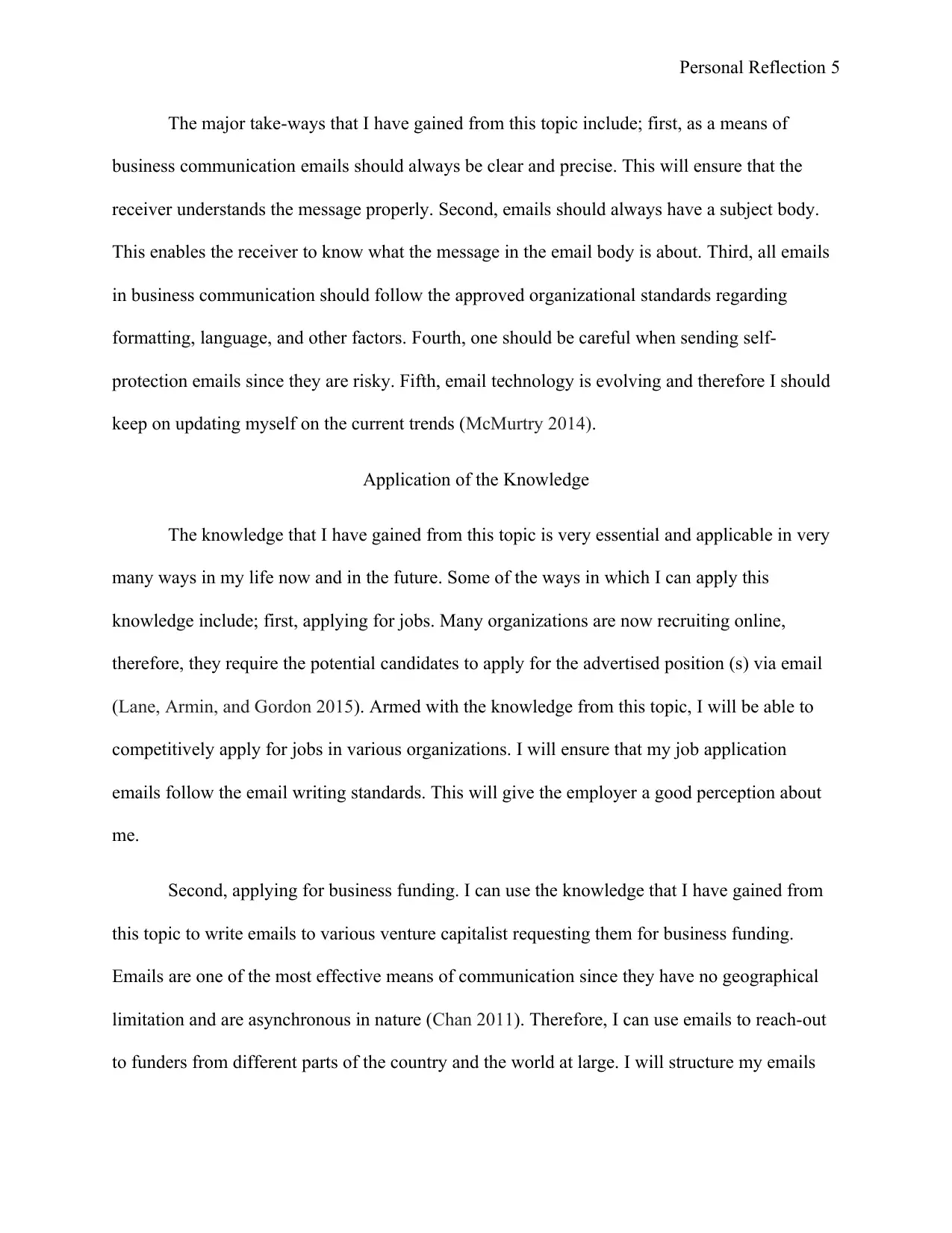
Personal Reflection 5
The major take-ways that I have gained from this topic include; first, as a means of
business communication emails should always be clear and precise. This will ensure that the
receiver understands the message properly. Second, emails should always have a subject body.
This enables the receiver to know what the message in the email body is about. Third, all emails
in business communication should follow the approved organizational standards regarding
formatting, language, and other factors. Fourth, one should be careful when sending self-
protection emails since they are risky. Fifth, email technology is evolving and therefore I should
keep on updating myself on the current trends (McMurtry 2014).
Application of the Knowledge
The knowledge that I have gained from this topic is very essential and applicable in very
many ways in my life now and in the future. Some of the ways in which I can apply this
knowledge include; first, applying for jobs. Many organizations are now recruiting online,
therefore, they require the potential candidates to apply for the advertised position (s) via email
(Lane, Armin, and Gordon 2015). Armed with the knowledge from this topic, I will be able to
competitively apply for jobs in various organizations. I will ensure that my job application
emails follow the email writing standards. This will give the employer a good perception about
me.
Second, applying for business funding. I can use the knowledge that I have gained from
this topic to write emails to various venture capitalist requesting them for business funding.
Emails are one of the most effective means of communication since they have no geographical
limitation and are asynchronous in nature (Chan 2011). Therefore, I can use emails to reach-out
to funders from different parts of the country and the world at large. I will structure my emails
The major take-ways that I have gained from this topic include; first, as a means of
business communication emails should always be clear and precise. This will ensure that the
receiver understands the message properly. Second, emails should always have a subject body.
This enables the receiver to know what the message in the email body is about. Third, all emails
in business communication should follow the approved organizational standards regarding
formatting, language, and other factors. Fourth, one should be careful when sending self-
protection emails since they are risky. Fifth, email technology is evolving and therefore I should
keep on updating myself on the current trends (McMurtry 2014).
Application of the Knowledge
The knowledge that I have gained from this topic is very essential and applicable in very
many ways in my life now and in the future. Some of the ways in which I can apply this
knowledge include; first, applying for jobs. Many organizations are now recruiting online,
therefore, they require the potential candidates to apply for the advertised position (s) via email
(Lane, Armin, and Gordon 2015). Armed with the knowledge from this topic, I will be able to
competitively apply for jobs in various organizations. I will ensure that my job application
emails follow the email writing standards. This will give the employer a good perception about
me.
Second, applying for business funding. I can use the knowledge that I have gained from
this topic to write emails to various venture capitalist requesting them for business funding.
Emails are one of the most effective means of communication since they have no geographical
limitation and are asynchronous in nature (Chan 2011). Therefore, I can use emails to reach-out
to funders from different parts of the country and the world at large. I will structure my emails
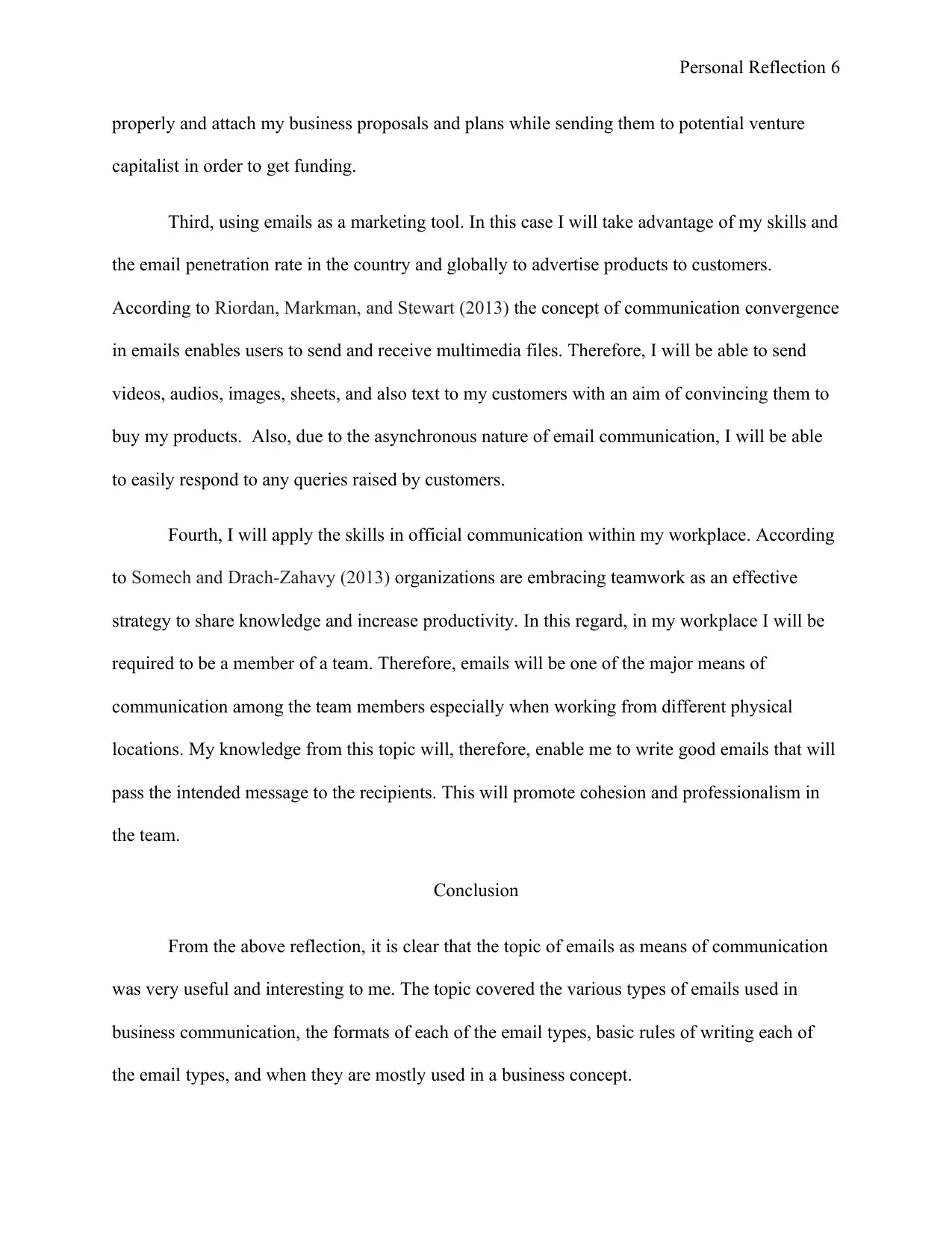
Personal Reflection 6
properly and attach my business proposals and plans while sending them to potential venture
capitalist in order to get funding.
Third, using emails as a marketing tool. In this case I will take advantage of my skills and
the email penetration rate in the country and globally to advertise products to customers.
According to Riordan, Markman, and Stewart (2013) the concept of communication convergence
in emails enables users to send and receive multimedia files. Therefore, I will be able to send
videos, audios, images, sheets, and also text to my customers with an aim of convincing them to
buy my products. Also, due to the asynchronous nature of email communication, I will be able
to easily respond to any queries raised by customers.
Fourth, I will apply the skills in official communication within my workplace. According
to Somech and Drach-Zahavy (2013) organizations are embracing teamwork as an effective
strategy to share knowledge and increase productivity. In this regard, in my workplace I will be
required to be a member of a team. Therefore, emails will be one of the major means of
communication among the team members especially when working from different physical
locations. My knowledge from this topic will, therefore, enable me to write good emails that will
pass the intended message to the recipients. This will promote cohesion and professionalism in
the team.
Conclusion
From the above reflection, it is clear that the topic of emails as means of communication
was very useful and interesting to me. The topic covered the various types of emails used in
business communication, the formats of each of the email types, basic rules of writing each of
the email types, and when they are mostly used in a business concept.
properly and attach my business proposals and plans while sending them to potential venture
capitalist in order to get funding.
Third, using emails as a marketing tool. In this case I will take advantage of my skills and
the email penetration rate in the country and globally to advertise products to customers.
According to Riordan, Markman, and Stewart (2013) the concept of communication convergence
in emails enables users to send and receive multimedia files. Therefore, I will be able to send
videos, audios, images, sheets, and also text to my customers with an aim of convincing them to
buy my products. Also, due to the asynchronous nature of email communication, I will be able
to easily respond to any queries raised by customers.
Fourth, I will apply the skills in official communication within my workplace. According
to Somech and Drach-Zahavy (2013) organizations are embracing teamwork as an effective
strategy to share knowledge and increase productivity. In this regard, in my workplace I will be
required to be a member of a team. Therefore, emails will be one of the major means of
communication among the team members especially when working from different physical
locations. My knowledge from this topic will, therefore, enable me to write good emails that will
pass the intended message to the recipients. This will promote cohesion and professionalism in
the team.
Conclusion
From the above reflection, it is clear that the topic of emails as means of communication
was very useful and interesting to me. The topic covered the various types of emails used in
business communication, the formats of each of the email types, basic rules of writing each of
the email types, and when they are mostly used in a business concept.
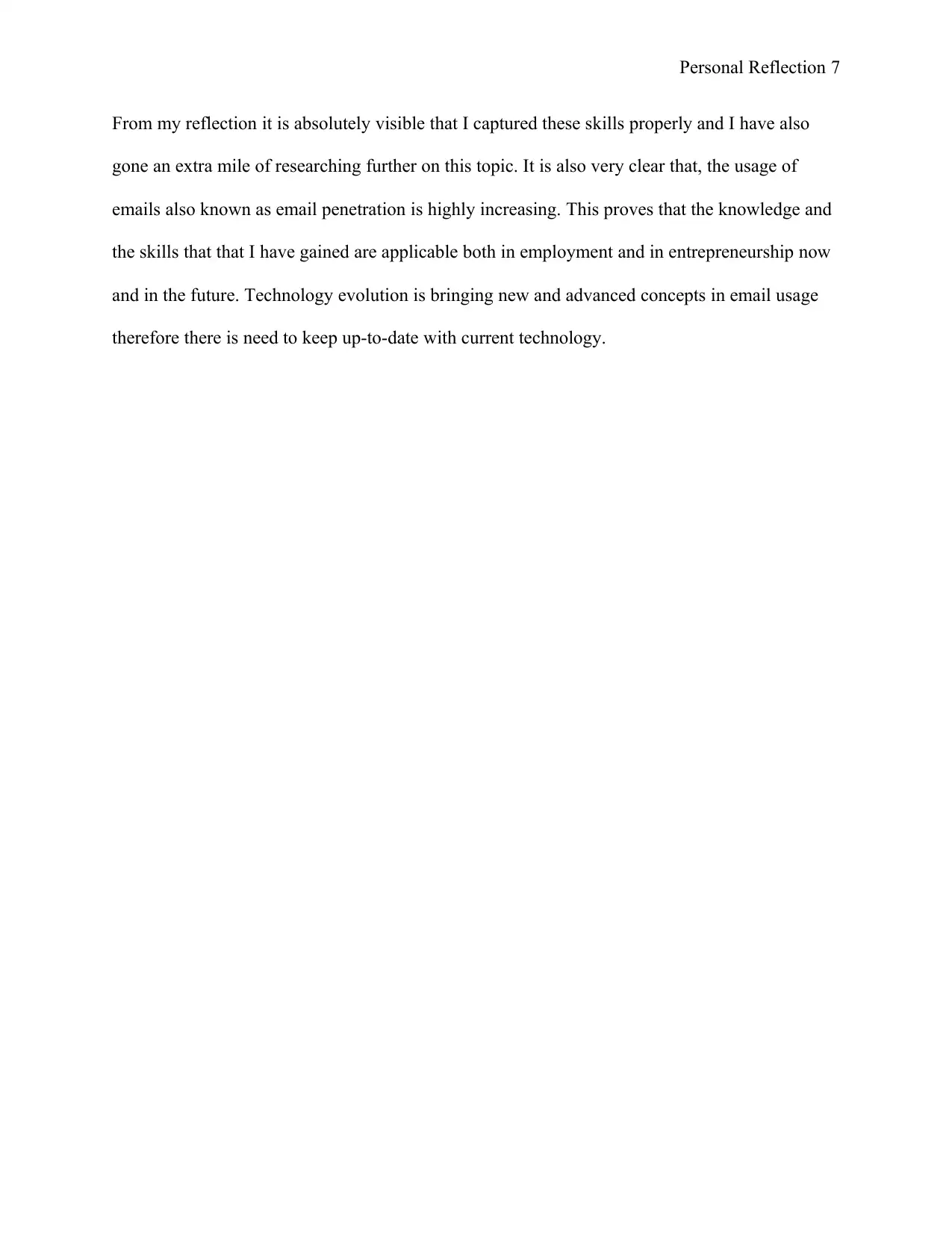
Personal Reflection 7
From my reflection it is absolutely visible that I captured these skills properly and I have also
gone an extra mile of researching further on this topic. It is also very clear that, the usage of
emails also known as email penetration is highly increasing. This proves that the knowledge and
the skills that that I have gained are applicable both in employment and in entrepreneurship now
and in the future. Technology evolution is bringing new and advanced concepts in email usage
therefore there is need to keep up-to-date with current technology.
From my reflection it is absolutely visible that I captured these skills properly and I have also
gone an extra mile of researching further on this topic. It is also very clear that, the usage of
emails also known as email penetration is highly increasing. This proves that the knowledge and
the skills that that I have gained are applicable both in employment and in entrepreneurship now
and in the future. Technology evolution is bringing new and advanced concepts in email usage
therefore there is need to keep up-to-date with current technology.
Paraphrase This Document
Need a fresh take? Get an instant paraphrase of this document with our AI Paraphraser
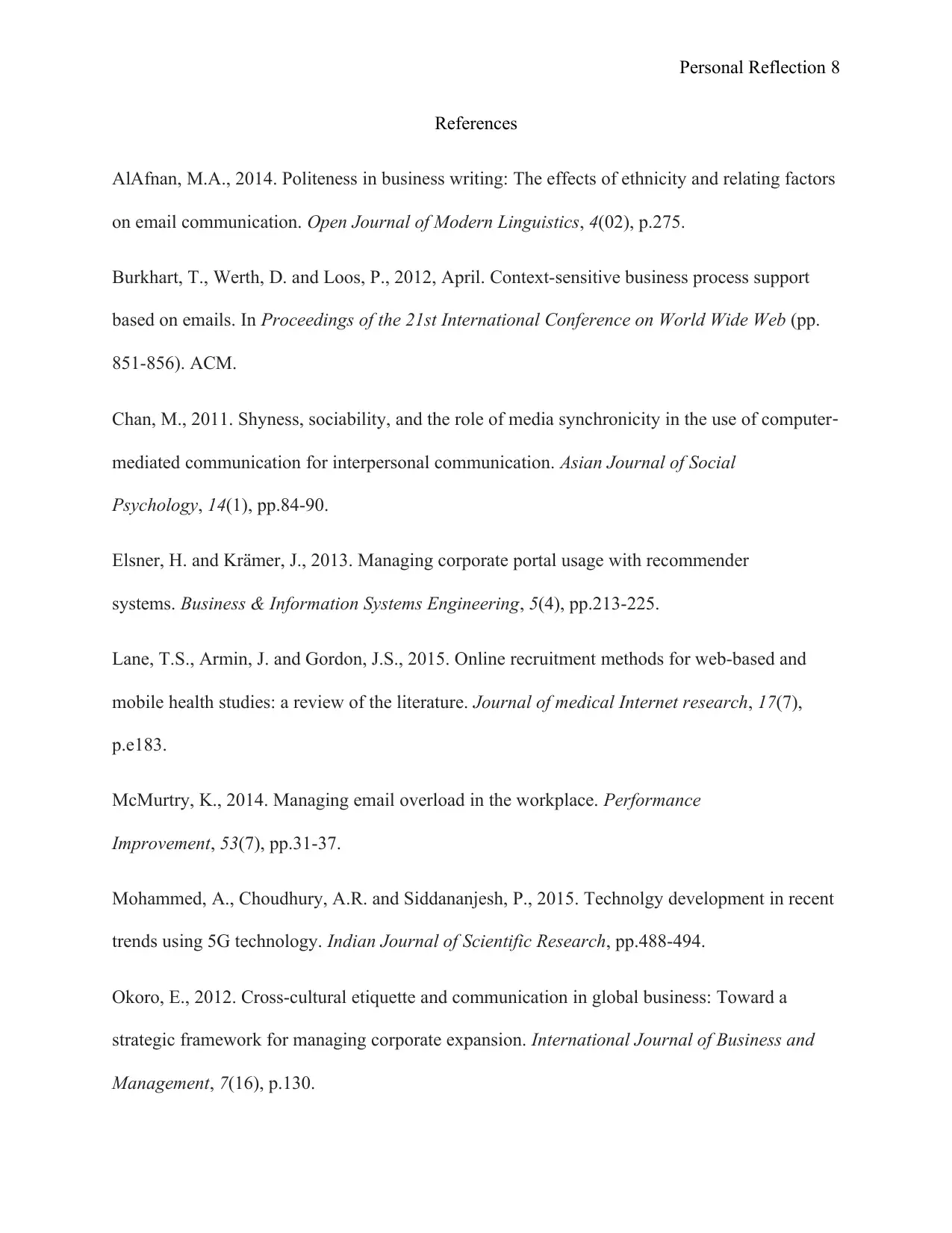
Personal Reflection 8
References
AlAfnan, M.A., 2014. Politeness in business writing: The effects of ethnicity and relating factors
on email communication. Open Journal of Modern Linguistics, 4(02), p.275.
Burkhart, T., Werth, D. and Loos, P., 2012, April. Context-sensitive business process support
based on emails. In Proceedings of the 21st International Conference on World Wide Web (pp.
851-856). ACM.
Chan, M., 2011. Shyness, sociability, and the role of media synchronicity in the use of computer‐
mediated communication for interpersonal communication. Asian Journal of Social
Psychology, 14(1), pp.84-90.
Elsner, H. and Krämer, J., 2013. Managing corporate portal usage with recommender
systems. Business & Information Systems Engineering, 5(4), pp.213-225.
Lane, T.S., Armin, J. and Gordon, J.S., 2015. Online recruitment methods for web-based and
mobile health studies: a review of the literature. Journal of medical Internet research, 17(7),
p.e183.
McMurtry, K., 2014. Managing email overload in the workplace. Performance
Improvement, 53(7), pp.31-37.
Mohammed, A., Choudhury, A.R. and Siddananjesh, P., 2015. Technolgy development in recent
trends using 5G technology. Indian Journal of Scientific Research, pp.488-494.
Okoro, E., 2012. Cross-cultural etiquette and communication in global business: Toward a
strategic framework for managing corporate expansion. International Journal of Business and
Management, 7(16), p.130.
References
AlAfnan, M.A., 2014. Politeness in business writing: The effects of ethnicity and relating factors
on email communication. Open Journal of Modern Linguistics, 4(02), p.275.
Burkhart, T., Werth, D. and Loos, P., 2012, April. Context-sensitive business process support
based on emails. In Proceedings of the 21st International Conference on World Wide Web (pp.
851-856). ACM.
Chan, M., 2011. Shyness, sociability, and the role of media synchronicity in the use of computer‐
mediated communication for interpersonal communication. Asian Journal of Social
Psychology, 14(1), pp.84-90.
Elsner, H. and Krämer, J., 2013. Managing corporate portal usage with recommender
systems. Business & Information Systems Engineering, 5(4), pp.213-225.
Lane, T.S., Armin, J. and Gordon, J.S., 2015. Online recruitment methods for web-based and
mobile health studies: a review of the literature. Journal of medical Internet research, 17(7),
p.e183.
McMurtry, K., 2014. Managing email overload in the workplace. Performance
Improvement, 53(7), pp.31-37.
Mohammed, A., Choudhury, A.R. and Siddananjesh, P., 2015. Technolgy development in recent
trends using 5G technology. Indian Journal of Scientific Research, pp.488-494.
Okoro, E., 2012. Cross-cultural etiquette and communication in global business: Toward a
strategic framework for managing corporate expansion. International Journal of Business and
Management, 7(16), p.130.
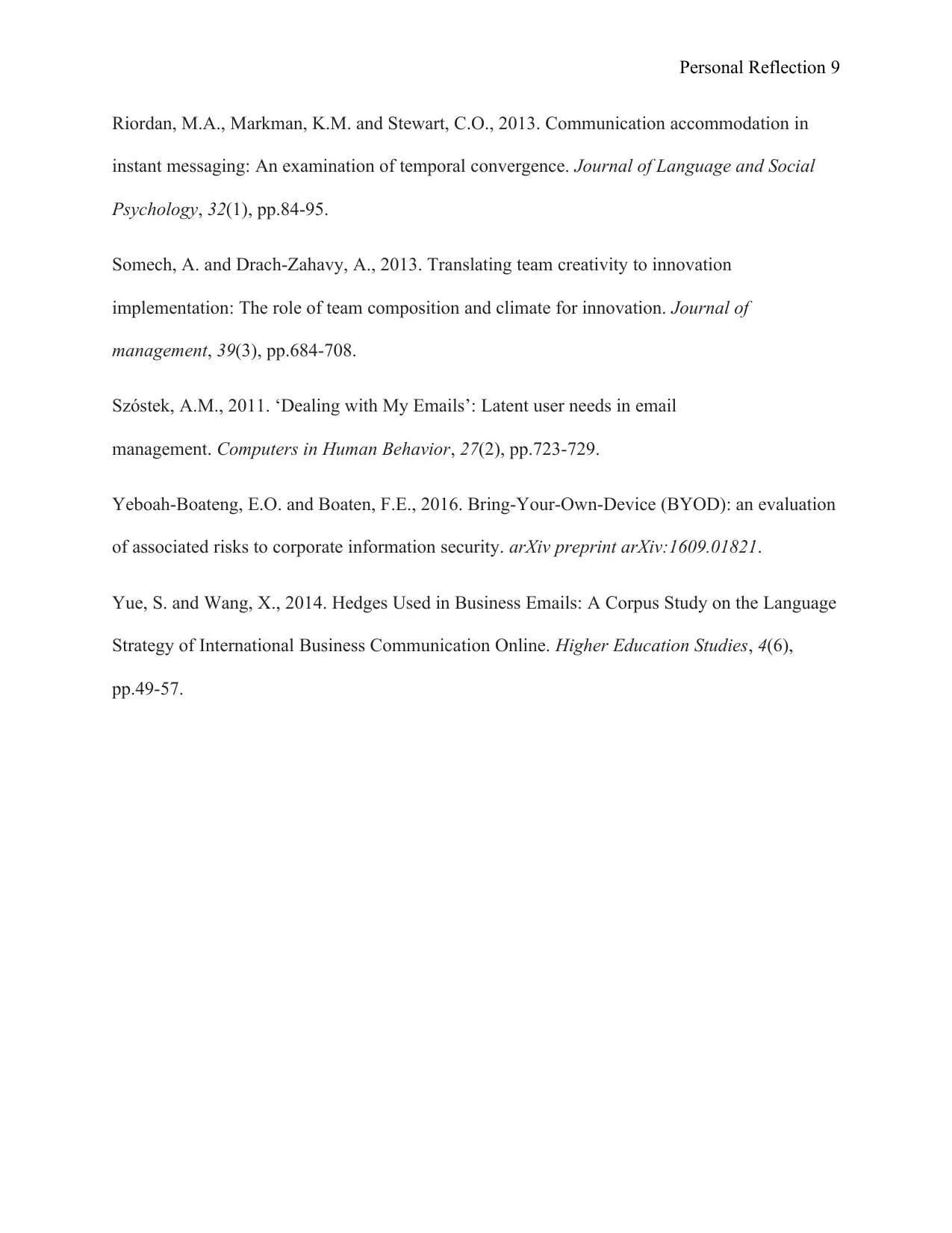
Personal Reflection 9
Riordan, M.A., Markman, K.M. and Stewart, C.O., 2013. Communication accommodation in
instant messaging: An examination of temporal convergence. Journal of Language and Social
Psychology, 32(1), pp.84-95.
Somech, A. and Drach-Zahavy, A., 2013. Translating team creativity to innovation
implementation: The role of team composition and climate for innovation. Journal of
management, 39(3), pp.684-708.
Szóstek, A.M., 2011. ‘Dealing with My Emails’: Latent user needs in email
management. Computers in Human Behavior, 27(2), pp.723-729.
Yeboah-Boateng, E.O. and Boaten, F.E., 2016. Bring-Your-Own-Device (BYOD): an evaluation
of associated risks to corporate information security. arXiv preprint arXiv:1609.01821.
Yue, S. and Wang, X., 2014. Hedges Used in Business Emails: A Corpus Study on the Language
Strategy of International Business Communication Online. Higher Education Studies, 4(6),
pp.49-57.
Riordan, M.A., Markman, K.M. and Stewart, C.O., 2013. Communication accommodation in
instant messaging: An examination of temporal convergence. Journal of Language and Social
Psychology, 32(1), pp.84-95.
Somech, A. and Drach-Zahavy, A., 2013. Translating team creativity to innovation
implementation: The role of team composition and climate for innovation. Journal of
management, 39(3), pp.684-708.
Szóstek, A.M., 2011. ‘Dealing with My Emails’: Latent user needs in email
management. Computers in Human Behavior, 27(2), pp.723-729.
Yeboah-Boateng, E.O. and Boaten, F.E., 2016. Bring-Your-Own-Device (BYOD): an evaluation
of associated risks to corporate information security. arXiv preprint arXiv:1609.01821.
Yue, S. and Wang, X., 2014. Hedges Used in Business Emails: A Corpus Study on the Language
Strategy of International Business Communication Online. Higher Education Studies, 4(6),
pp.49-57.
1 out of 9
Related Documents
Your All-in-One AI-Powered Toolkit for Academic Success.
+13062052269
info@desklib.com
Available 24*7 on WhatsApp / Email
![[object Object]](/_next/static/media/star-bottom.7253800d.svg)
Unlock your academic potential
© 2024 | Zucol Services PVT LTD | All rights reserved.




